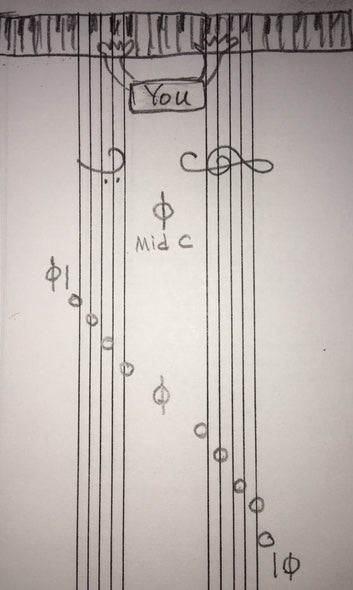Beginner piano students always get confused about reading notes in the treble clef and notes in the bass clef. They ask me why the notes are not read the same way in both clefs. But it's actually easy. Try this: Rotate your sheet music or music book that has both clefs on it clockwise 90 degrees. If you do so, it's going to look like the 1st drawing on this page. You see the 10 lines (5 lines for bass clef and 5 lines for treble clef) vertically now.

I drew a picture of piano (sorry it's ugly) on the top of this paper as you can see. [You] is a place you are sitting in front of the piano trying to play the piano. Below that I drew a middle C. As you can see, the middle C is in the middle between bass clef and treble clef. And if you look up and see the piano, that's where middle C is on the piano as well. Lower notes on the bass clef are of course on the left side of the piano. And higher notes on the treble clef are on the right side of the piano. Notes are all actually lined up!!!
I have a feeling that hundreds of years ago when the music started to be notated, musicians might have been writing the notes from the top to bottom instead of from the left to right when the music was moving in time.
Do you know what a player piano is? A player piano is like a music box. The piano plays itself without a person playing it. And inside the player piano, there is a roll of metal with pins on it. These pins are basically the notes. And the roll of metal is basically like the staves. But staves move from the top to the bottom like a toilet paper, not from left to right. While the roll is moving, the pins that are stuck out get hit by a bar, and it plays those specific keys (notes) at a certain time. If 3 pins are lined up horizontally (for example), 3 keys are going to be played at the same time. Music notation on sheet music or book is just like this metal roll inside the player piano.
Reading blocked chords will be done much quicker using this method. Just rotate the music 90 degrees clockwise in your mind. You'll see the exact shape of a chord on the paper that applies to the piano the same way. See the 2nd drawing on this blog page.

There is another reason why understanding this and using this method is important. Let's pick just one note, for example, C. Even if you can name a note on the book as "C," do you know which C it is? There are 8 Cs on the piano. But if you can see the staves and 88 keys lined up like the picture above, you can easily find which C the note is showing on the staff. This is essential.
So, I encourage all of you who are just starting to learn how to read piano music on both bass clef and treble clef, to use this concept. It is just a concept. You have to picture the music in the rotated position in your mind while you still read music from left to right. But if you do that, reading notes on staves and finding appropriate keys on the piano is going to be much more effortless. And you won't be complaining about why treble clef notes and bass clef notes look different.
